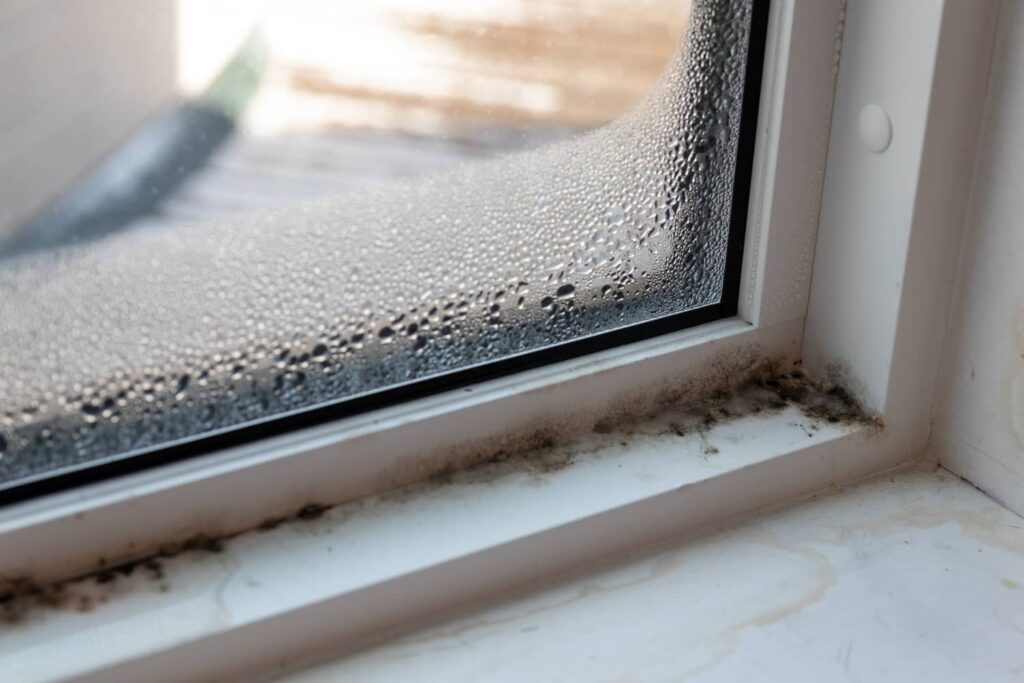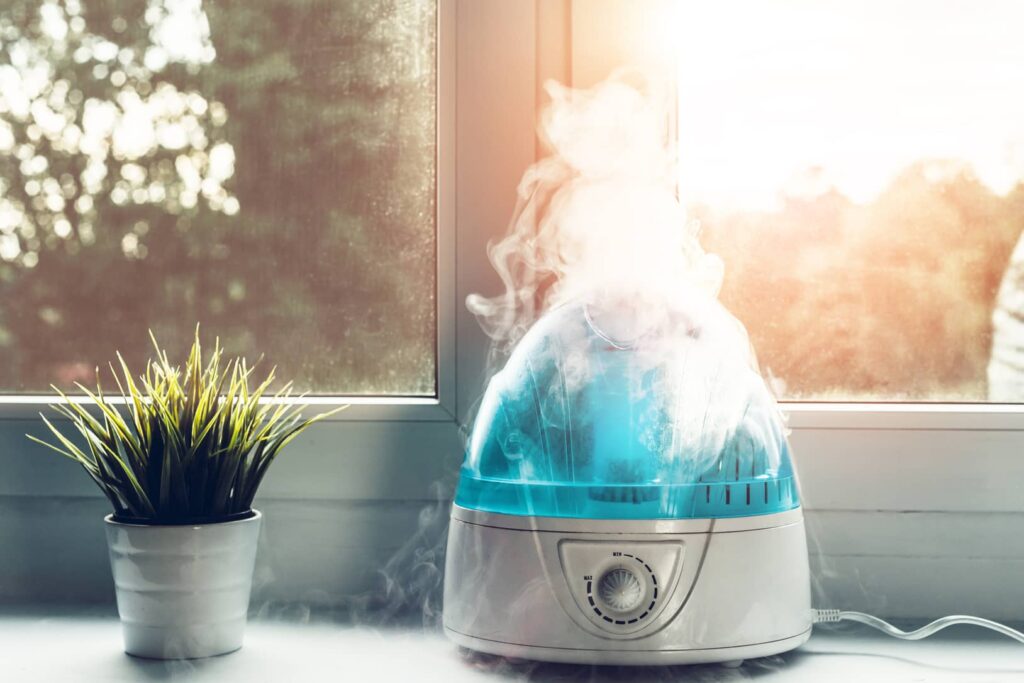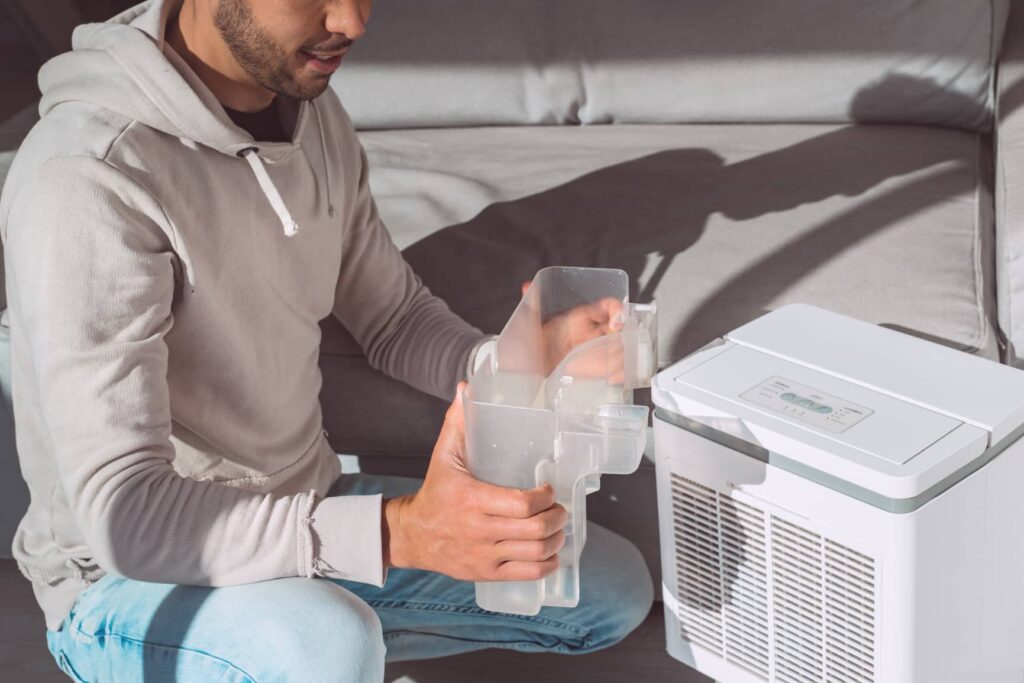Depending on where you live and the type of HVAC system that you have in your home, can often determine if a humidifier is needed. During some parts of the year, you might notice that the air in your home is dryer which can cause some uncomfortable health symptoms. Homeowners will purchase a humidifier unit to create moisture in the air in the home. This can reduce the homeowner’s uncomfortable symptoms, such as cracked lips, bloody noses, or dry sinuses. Keep in mind that adding moisture to the air in your home can promote mold growth. Can humidifiers cause mold? They can produce a breeding ground for mold and often develop mold in the water basin of the unit.
Let’s take a look below at some more details regarding a humidifier and its potential for producing mold.
What Is Mold
Mold is a fungus that can be easily identified on various surfaces or food products. It often appears in areas that have high humidity and moisture counts. Also, mold can appear in various color forms such as black, white, orange, green, or purple. Some molds are more dangerous than others. Additionally, allowing mold to grow in your home can cause some major health issues. What might start as mild symptoms can quickly turn into a severe health concern.

What Are Humidifiers
Have a humidifier in your home to create added moisture in the air. Also, homeowners that are often experiencing dry sinuses, bloody noses, or even cracked lips will turn to a humidifier to help with the healing process. Let’s take a look below at the types of humidifiers you might look to purchase.
- Steam vaporizer – steam is created by electricity. Plugging in the steam vaporizer allows the machine to cool the air and release it into the room. Always be careful as this type of humidifier utilizes hot water that can cause severe burns if not cared for properly.
- Evaporators – fans will blow the air across a wet wick, filter, or belt.
- Central humidifier – built into the HVAC system. Can humidify the entire home.
- Ultrasonic humidifier – ultrasonic vibrations create a cool mist for the room.
- Impeller humidifier – rotating disks will produce the cool mist for the room.

How Do I Know If Mold Is Growing
Simply put, you will notice the mold spores begin to show on various surfaces with high moisture. Mold most often appears in your bathroom shower or tub first as the steam from your shower can attract the spores. Also, mold can grow within 24 to 48 hours of finding the right moisture conditions. The following is a list of items that can promote mold growth in your home.
- Humidifier
- Condensation
- Poor ventilation
- Damp basement
- Leaks in the roof
- Wet clothes in various rooms of the home.
- Leaking water pipes in the home.
- Flooding in the home.
What Are Some Ways To Prevent It
Believe it or not, keeping mold from growing in your home due to the use of a portable humidifier can be rather simple. Also, keep in mind that cleaning the humidifier on a regular basis is a great step forward. Let’s take a look below at a list of ways to keep the humidifier from causing mold in the home.
- Water type – manufacturers recommend that you use distilled or demineralized water instead of tap water. These two types of water have fewer minerals that can cause deposits and promote bacterial growth. If the water is dirty, then the contaminated water will be changed into steam and forced into the air. Essentially, creating dirty air in your home.
- Water change – never let the water sit for too long in the humidifier reservoir. Empty the tanks and dry them out. Wipe down any wet surface to make sure that all water in your humidifier is removed.
- Clean the unit – you should focus on cleaning a humidifier at least every 3 days. This allows you to remove any mineral build up on the tank. Manufacturers recommend using a solution of 3% hydrogen peroxide to disinfect the unit. If you do not have that available, then consider a bleach solution or other disinfecting products like white vinegar.
- Rinse – thoroughly rinse the humidifier after you have cleaned it. Also, make sure you remove all chemical solutions prior to you creating more steam for the room.
- Filter change – just like you would change the filters on your AC unit, you need to change the filter in your humidifier.
- Keep it dry – make sure to clean up any spilled water around the humidifier. If dampness or condensation is beginning to form, turn the temperature of the humidifier down or limit the usage of the unit.
- Storage – make sure that you clean the unit, rinse the unit, dry the unit, and discard of any filter cartridges before putting the unit away.
- Central humidifier – if you happen to have a central humidifier built into your HVAC system, then simply maintain the system as you would the other parts of your HVAC unit.
- Too old – simply replace any old humidifier. They last as long as they are maintained, however, they don’t last forever.
- Monitor humidity – if humidity levels exceed 55% the room becomes a breeding ground for mold. Also, try to keep humidity levels between 30% and 50% and use a digital hygrometer to monitor humidity levels in your home.
Other Recommended Maintenance
Now that you have a better understanding of how humidifiers can promote mold growth. It is a good idea to further understand how your HVAC system can produce quality air and prevent mold growth.
Next, read up on what mold is and how fast mold can grow. Understanding how mold operates and what environmental conditions can allow mold to start growing is key. As a homeowner, you will want to stay ahead of any potential disaster of repairs in the home. Essentially, gaining an understanding of how fast mold can grow can substantially increase your preventative maintenance.
Lastly, keep in mind that mold can grow in a variety of places. The dampest and darkest places are breeding grounds for mold. Mold is attracted to any place that has high humidity and moisture percentage and can grow quickly. One of the most likely areas for mold to grow is in your basement. Understand that mold growing in your basement can end up having a direct link to your upstairs living space. Getting a mold remediation team out to your home as quickly as possible would be your best bet.

When Do I Call A Professional
Whenever you are dealing with mold you will want to call on a professional mold remediation team. If you are concerned about how to operate your home humidifier, you can consult the manufacturer’s manual. Also, calling on your local home inspection team to take a look around your home for mold concerns is a great idea. If you do have a mold issue the home inspection team can recommend a reputable mold remediation team as well as recommend any repairs or replacement ideas.
Conclusion
Before you purchase a humidifier for your home it is important to read the manufacturer comparisons to see which one is the best fit for your home. Also understanding how to clean the humidifier and keep it from promoting mold growth in your home is important. If you aren’t sure what makes sense for your home, or even if you have a central humidifier built into your HVAC system, call on your local home inspection team. Additionally, they can assess the humidity and moisture in your home and inspect your HVAC system, windows, and doors for functionality. Call on Enviroquest Home Inspections for a mold inspection and complete home inspections in Harrisburg, PA.
